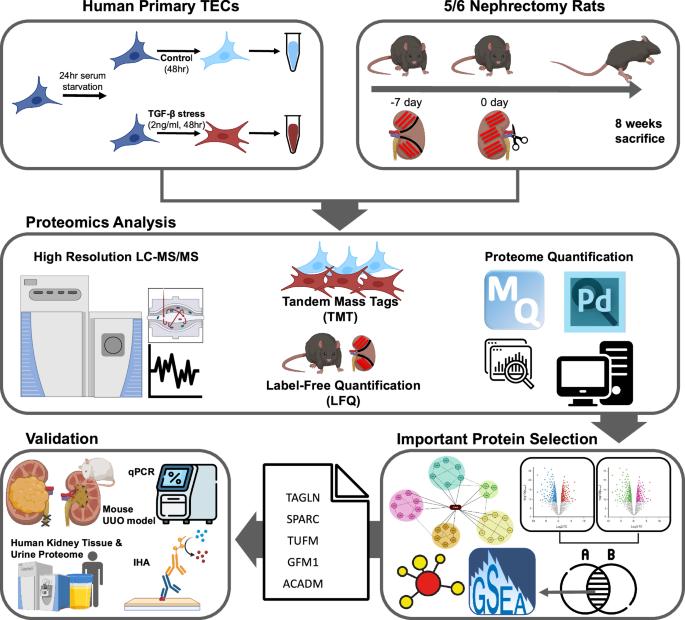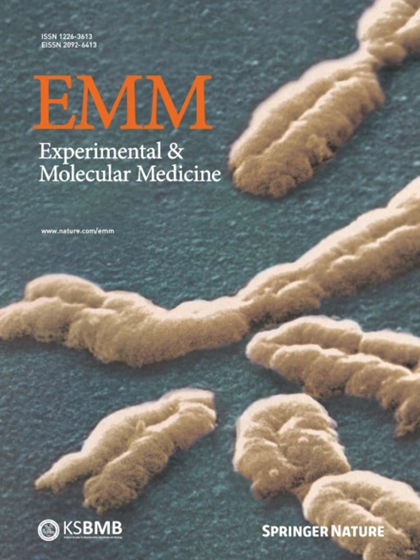Unveiling the role of transgelin as a prognostic and therapeutic target in kidney fibrosis via a proteomic approach
IF 9.5
2区 医学
Q1 BIOCHEMISTRY & MOLECULAR BIOLOGY
引用次数: 0
Abstract
Chronic kidney disease (CKD) progression involves tubulointerstitial fibrosis, a process characterized by excessive extracellular matrix accumulation. To identify potential biomarkers for kidney fibrosis, we performed mass spectrometry-based proteomic profiling of human kidney tubular epithelial cells and kidney tissue from a 5/6 nephrectomy rat model. Multidisciplinary analysis across kidney fibrosis models revealed 351 differentially expressed proteins associated with kidney fibrosis, and they were enriched in processes related to the extracellular matrix, kidney aging, and mitochondrial functions. Network analysis of the selected proteins revealed five crucial proteins, of which transgelin emerged as a candidate protein that interacts with known fibrosis-related proteins. Concordantly, the gene expression of transgelin in the kidney tissue from the 5/6 nephrectomy model was elevated. Transgelin expression in kidney tissue gradually increased from intermediate to advanced fibrosis stages in 5/6 Nx rats and mice with unilateral ureteral obstruction. Subsequent validation in kidney tissue and urine samples from patients with CKD confirmed the upregulation of transgelin, particularly under advanced disease stages. Moreover, we investigated whether blocking TAGLN ameliorated kidney fibrosis and reduced reactive oxygen species levels in cellular models. In conclusion, our proteomic approach identified TAGLN as a potential noninvasive biomarker and therapeutic target for CKD-associated kidney fibrosis, suggesting its role in modulating mitochondrial dysfunction and oxidative stress responses. Chronic kidney disease is caused by kidney fibrosis, where healthy kidney tissue becomes scar, affecting kidney function. This research aimed to find noninvasive signs of kidney fibrosis by studying proteins in human kidney cells and animal CKD models. They used mass spectrometry, a method to identify and quantify proteins, to find potential signs in the body fluids that could show kidney fibrosis without needing kidney biopsy. The study found that the protein TAGLN increases in kidney tissue and urine in CKD conditions, suggesting it could be a useful sign of kidney fibrosis. Further tests showed that blocking TAGLN could reduce kidney fibrosis, indicating its potential as a target for new treatments. The researchers conclude that TAGLN is a promising sign of kidney fibrosis and could lead to better diagnostic and treatment options for CKD patients. This summary was initially drafted using artificial intelligence, then revised and fact-checked by the author.

通过蛋白质组学方法揭示转胰蛋白酶在肾脏纤维化中作为预后和治疗靶点的作用。
慢性肾脏病(CKD)的进展涉及肾小管间质纤维化,这一过程的特点是细胞外基质过度积累。为了确定肾脏纤维化的潜在生物标志物,我们对人类肾小管上皮细胞和来自 5/6 肾切除大鼠模型的肾组织进行了基于质谱的蛋白质组分析。通过对肾脏纤维化模型进行多学科分析,发现了351个与肾脏纤维化相关的差异表达蛋白,这些蛋白富集在与细胞外基质、肾脏衰老和线粒体功能相关的过程中。对所选蛋白的网络分析发现了五个关键蛋白,其中转髓鞘蛋白是与已知纤维化相关蛋白相互作用的候选蛋白。与此相一致的是,5/6肾切除模型肾组织中转铁蛋白的基因表达升高。在 5/6 Nx 大鼠和单侧输尿管梗阻小鼠的肾组织中,转胰蛋白的表达从中级到高级纤维化阶段逐渐增加。随后在慢性肾脏病患者的肾组织和尿液样本中进行的验证证实了转铁蛋白的上调,尤其是在疾病晚期。此外,我们还研究了在细胞模型中阻断 TAGLN 是否能改善肾脏纤维化并降低活性氧水平。总之,我们的蛋白质组学方法发现 TAGLN 是一种潜在的非侵入性生物标记物,也是 CKD 相关肾脏纤维化的治疗靶点,这表明它在调节线粒体功能障碍和氧化应激反应中的作用。
本文章由计算机程序翻译,如有差异,请以英文原文为准。
求助全文
约1分钟内获得全文
求助全文
来源期刊

Experimental and Molecular Medicine
医学-生化与分子生物学
CiteScore
19.50
自引率
0.80%
发文量
166
审稿时长
3 months
期刊介绍:
Experimental & Molecular Medicine (EMM) stands as Korea's pioneering biochemistry journal, established in 1964 and rejuvenated in 1996 as an Open Access, fully peer-reviewed international journal. Dedicated to advancing translational research and showcasing recent breakthroughs in the biomedical realm, EMM invites submissions encompassing genetic, molecular, and cellular studies of human physiology and diseases. Emphasizing the correlation between experimental and translational research and enhanced clinical benefits, the journal actively encourages contributions employing specific molecular tools. Welcoming studies that bridge basic discoveries with clinical relevance, alongside articles demonstrating clear in vivo significance and novelty, Experimental & Molecular Medicine proudly serves as an open-access, online-only repository of cutting-edge medical research.
 求助内容:
求助内容: 应助结果提醒方式:
应助结果提醒方式:


